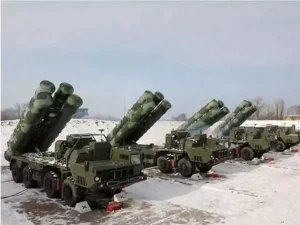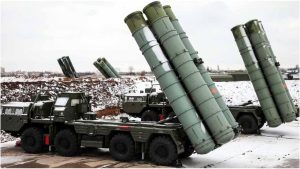New Delhi – What is S-400 missile system? This question has become increasingly relevant in global defense discussions as nations seek to bolster their air security infrastructure. The S-400 Triumf represents the pinnacle of Russian air defense technology, combining long-range detection capabilities with versatile missile interception systems designed to neutralize multiple aerial threats simultaneously.
Technical Specifications and Capabilities
Understanding what is S-400 missile system requires examining its impressive technical profile. The system consists of three primary components: sophisticated missile launchers, advanced radar systems, and an integrated command center. The S-400 can track up to 80 targets simultaneously while engaging up to 36 targets at once.

What is S-400 missile system’s operational range? The system employs multiple missiles to engage targets at varying distances:
- 40N6 missiles with a 400 km range for high-altitude targets
- 48N6 missiles with a 250 km range for medium-range interception
- 9M96 missiles with 120 km range for shorter-range threats
- 9M96E2 missiles with 40 km range for close-quarter defense
This multi-layered approach allows the S-400 to create an impenetrable dome of protection extending hundreds of kilometers from its deployment location. What is S-400 missile system’s detection capability? Its radar can identify threats at distances up to 600 kilometers, providing crucial early warning for defensive measures.
Also Read: Operation Sindoor: Powerful Indian Strike Targets 9 Terrorist Camps in POK
India’s Acquisition and Strategic Implementation
In October 2018, India finalized a landmark $5 billion agreement with Russia to acquire five units of the S-400 system. When examining what is S-400 missile system’s importance to India, this represented a significant enhancement to the nation’s air defense capabilities. The Indian Ministry of Defence stated: “The S-400 Missile is a potent system in terms of its operational capability to provide continuous and effective air defense system to a very large area. With the induction of this system, air defense capability of the nation will be significantly enhanced.”


Recent Defensive Victory: Protecting 15 Indian Cities
What is S-400 missile system’s effectiveness in real combat scenarios? Recent events have provided a definitive answer. According to reports from news agency ANI citing defense sources, the S-400 system was recently instrumental in neutralizing a coordinated missile attack targeting 15 Indian cities. Pakistan reportedly launched missiles aimed at military installations across several strategic locations, including Awantipura, Srinagar, Jammu, Pathankot, Amritsar, Kapurthala, Jalandhar, Ludhiana, Adampur, Bathinda, Chandigarh, Nal, Phalodi, Uttarlai, and Bhuj.
What is S-400 missile system’s role in this defensive operation? Working in conjunction with India’s Integrated Counter UAS Grid and complementary air defense systems, the S-400 successfully detected, tracked, and intercepted these incoming threats before they could reach their targets. This demonstrated the system’s critical importance in protecting civilian populations and military assets from modern aerial threats.
Global Significance and NATO Concerns
What is S-400 missile system’s standing in global defense hierarchies? NATO members consider it a formidable threat due to its exceptional detection and interception capabilities. The system can effectively engage nearly all varieties of modern combat aircraft, including stealth fighters, giving it strategic significance well beyond conventional air defense systems.
What is S-400 missile system’s advantage over competing technologies? Its ability to simultaneously counter multiple threat types—from aircraft and cruise missiles to ballistic missiles—at various altitudes and ranges makes it uniquely versatile. Few defense systems globally can match this comprehensive protection profile.
Technical Innovations and Design Philosophy
What is S-400 missile system’s technological foundation? The system represents decades of Russian expertise in anti-aircraft and anti-missile design. The S-400’s 91N6E surveillance radar can identify and track airborne targets at extraordinary distances, while its 92N6E fire control radar provides precision guidance for missile interception.
What is S-400 missile system’s deployment flexibility? Each battery can operate independently or as part of an integrated network, allowing for strategic placement across large territories. The system achieves operational readiness within minutes of arrival at a deployment site, providing rapid response capabilities during emergencies.
International Relations and Sanctions Considerations


What is S-400 missile system’s impact on international relations? India’s acquisition of the system despite potential sanctions under the U.S. Countering America’s Adversaries Through Sanctions Act (CAATSA) demonstrates its strategic importance. For India, enhancing national security through this advanced system outweighed potential diplomatic complications.
Future Developments and Strategic Implications
What is S-400 missile system’s future in modern warfare? As aerial threats continue to evolve, including hypersonic missiles and drone swarms, the S-400’s modular design allows for updates and adaptations. Russia has already begun developing the S-500 system, indicating an ongoing commitment to advancing this defensive technology.
Conclusion
What is S-400 missile system’s ultimate significance? Beyond its technical specifications, the system represents a transformative approach to territorial air defense. For India, its recent successful protection of 15 cities from missile attacks demonstrates the wisdom of investing in this advanced technology. As aerial warfare continues to evolve, the S-400 stands as a powerful deterrent against potential aggressors and a crucial component of national security infrastructure.
The S-400 Triumf has proven itself not merely as a defensive asset but as a strategic force multiplier that fundamentally alters the regional security calculus. Nations possessing this system gain not only protection but also increased geopolitical leverage in an increasingly complex security environment.

